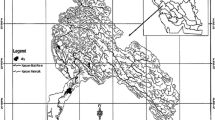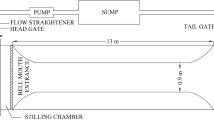Abstract
This briefing article presents gene-expression programming (GEP), which is an extension to genetic programming, as an alternative approach to predict friction factor for Southern Italian rivers. Published data were compiled for the friction for 43 gravel-bed rivers of Calabria. The proposed GEP approach produces satisfactory results (R 2 = 0.958 and RMSE = 0.079) compared with existing predictors.



Similar content being viewed by others
References
Alavi AH, Gandomi AH (2011) A robust data mining approach for formulation of geotechnical engineering systems. Eng Comput 28(3):242–274
Alavi AH, Ameri M, Gandomi AH, Mirzahosseini MR (2011) Formulation of flow number of asphalt mixes using a hybrid computational method. Constr Build Mater 25(3):1338–1355
Azamathulla HMd, Ghani AA, Zakaria NA, Guven A (2010) Genetic programming to predict bridge pier scour. ASCE J Hydraul Eng 136(3):165–169
Bathurst JC, Li R, Simons DB (1981) Resistance equation for large-scale roughness. J Hydraul Div ASCE 107(HY12):1593–1613
Bray DI (1979) Estimating average velocity in gravel-bed rivers. J Hydraul Div ASCE 105(HY12):1103–1122
Colosimo C, Vito AC, Veltri M (1988) Friction factor evaluation in gravel-bed rivers. J Hydraul Eng 114(8):861–876
Ferreira C (2001) Gene expression programming in problem solving. 6th Online world conference on soft computing in industrial applications (invited tutorial)
Ferreira C (2001) Gene expression programming: a new adaptive algorithm for solving problems. Complex Syst 13(2):87–129
Gandomi AH, Alavi AH, Mirzahosseini MR, Moqhadas Nejad F (2011) Nonlinear genetic-based models for prediction of flow number of asphalt mixtures. J Mater Civ Eng ASCE 23(3):248–263
Gandomi AH, Babanajad SK, Alavi AH, Farnam Y (2012) A novel approach to strength modeling of concrete under triaxial compression. J Mater Civ Eng ASCE. doi:10.1061/(ASCE)MT.1943-5533.0000494
Gandomi AH, Tabatabaie SM, Moradian MH, Radfar A, Alavi AH (2011) A new prediction model for load capacity of castellated steel beams. J Constr Steel Res 67(7):1096–1105
GEPSOFT (2006) GeneXproTools. Version 4.0, http://www.gepsoft.com
Giustolisi O (2004) Using genetic programming to determine Chèzy resistance coefficient in corrugated channels. J Hydroinform 6(3):157–173
Graf WH, Cao HH, Suszka L (1983) Hydraulics of steep mobile-bed channels. In: Proceedings of 20th congress of the international association for hydraulic research, Moscow, USSR
Griffiths GA (1981) F low resistance in coarse gravel-bed rivers. J Hydraul Div ASCE 107(HY7):899–916
Guven A, Gunal M (2008) Genetic programming approach for prediction of local scour downstream of hydraulic structures. J Irrig Drain Eng 134(2):241–249
Guven A, Gunal M (2008) Prediction of scour downstream of grade-control structures using neural networks. J Hydraul Eng 134(11):1656–1660
Guven A, Aytek A (2009) A new approach for stage-discharge relationship: gene-expression programming. ASCE J Hydrol Eng 14(8):812–820
Hey RD (1979) Flow resistance in gravel-bed rivers. J Hydraul Div ASCE 105(HY4):365–379
Jarrett RD (1994) Historic-flood evaluation and research needs in mountainous areas. In: Cotroneo GV, Rumer RR (eds) Hydraulic engineering—proceedings of the symposium sponsored by the American Society of Civil Engineers, Buffalo, NY, 1–5 Aug 1994. American Society of Civil Engineers, New York, pp 875–879
Koza JR (1992) Genetic programming: on the programming of computers by means of natural selection. A Bradford book. MIT Press, Cambridge
Kumar B (2011) Flow resistance in alluvial channel. Water Resour 38(6):745–754
Kumar B, Rao AR (2010) Metamodeling approach to predict friction factor of alluvial channel. Comput Electron Agric 70(1):144–150
Kumar B, Bhatla A (2010) Genetic algorithm optimized neural network prediction of the friction factor in a mobile bed channel. J Intell Syst 19(4):315–335
Limerinos JT (1970) Determination of the Manning coefficient from measured bed roughness in natural channels. Water supply paper 1898-B, USGS, Washington, DC
Marchi E (1961) II moto uniforme delle correnti liquid nei condotti chiusi e aperti. L’ Energia Elettrica, Milano, Italy, No. 4–5, 289–301 (Italian)
Motamedi A, Afzalimehr H, Singh VP (2010) Estimation of friction factor in open channels. J Hydrol Eng 15(3):249–254
Peterson DF, Mohanty PK (1960) Flume studies of flow in steep rough channels. J Hydraul Div ASCE 86(HY9):55–76
Rouse H (1965) Critical analysis of open-channel resistance. J Hydraul Div ASCE 91(HY4):1–25
Teodorescu L, Sherwood D (2008) High energy physics event selection with gene expression programming. Comput Phys Commun 178(6):409–419
Yalin MS (1972) Mechanics of sediment transport, 1st edn. Pergamon Press, New York
Yarahamadi MB, Fathi-Moghadam M, Bajestan MS (2010) Effects of land slope and flow depth on retarding flow in gravel-bed lands. World Appl Sci J 8(8):943–947
Yen BC (2002) Open channel flow resistance. J Hydraul Eng 128(1):20–39
Author information
Authors and Affiliations
Corresponding author
Rights and permissions
About this article
Cite this article
Md. Azamathulla, H. Gene-expression programming to predict friction factor for Southern Italian rivers. Neural Comput & Applic 23, 1421–1426 (2013). https://doi.org/10.1007/s00521-012-1091-2
Received:
Accepted:
Published:
Issue Date:
DOI: https://doi.org/10.1007/s00521-012-1091-2




